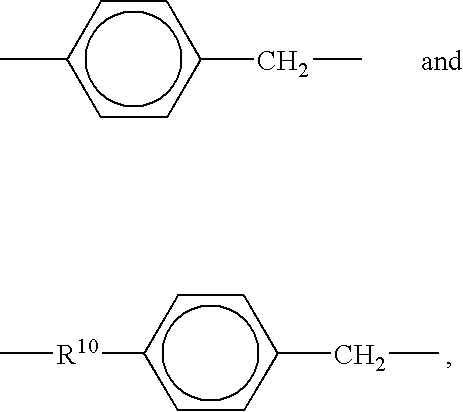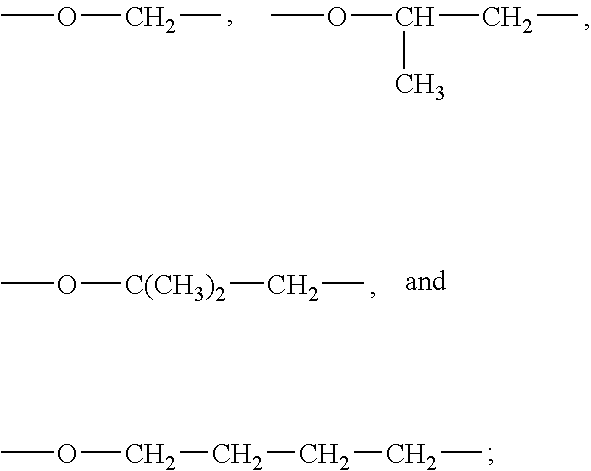Adhesive
a technology of adhesives and adhesives, applied in the direction of polyether adhesives, magnetic/electric field screening, electrical equipment, etc., can solve the problems of difficult mechanical operation, complicated and difficult polymerization chemistry, and inability to be widely accepted, so as to achieve minimal tooling investment and less labor
- Summary
- Abstract
- Description
- Claims
- Application Information
AI Technical Summary
Benefits of technology
Problems solved by technology
Method used
Image
Examples
example 1
Adhesion Test on Copper Plates
[0080] An adhesive composition of a two-polymer component system is made. The first polymer is a trimethoxy silyl ether polymer having an average molecular weight of 5000 Daltons weight units and the second polymer is a random polybutadiene containing both 1,4 and 1,2 butadiene units. The polybutadiene polymer has pendent anhydride functionalities, which compose 20 wt % of the polybutadiene polymer. The anhydride functionalities are derived from maleic anhydride. The average molecular weight of the polybutadiene polymer is 250,000 Daltons.
[0081] The trimethoxy silyl ether polymer is blended with the polybutadiene polymer in a weight ratio of 98:2. The polymers are blended together in a Bandbury type of mixer at 20° C. until a uniform mixture is obtained.
[0082] Diisopropoxybis(2,4-pentanedionato)-titanium catalyst is added in a sufficient amount to the polymer mixture such that it composes 0.1 wt % of the mixture. Vinyl trimethoxy silane and polyethyl...
example 2
Adhesion to Aluminum Plates
[0085] An adhesive composed of a dimethoxy silyl ether polymer having an average molecular weight of 20,000 Daltons and a second polymer which is a random polybutadiene containing both 1,4 and 1,2 butadiene units. The average molecular weight of the random polybutadiene is 200,000 Daltons. The polybutadiene polymer has pendent anhydride and acid functionalities, which compose 30 wt % of the polybutadiene polymer. The anhydride and acid functionalities are derived from maleic anhydride and esters of maleic acid such as monomethyl maleic acid, dimethyl maleic acid and diethyl maleic acid.
[0086] The dimethoxy silyl ether polymer is blended with the polybutadiene polymer in a weight ratio of 90:10. The polymers are blended together in a Bandbury type mixer at 22° C. until a uniform mixture is obtained.
[0087] Dibutyl tin dilaurate catalyst is added in a sufficient amount to the polymer mixture such that it composes 0.5 wt % of the mixture. Vinyl trimethoxy s...
example 3
Adhesion to Electroless Nickel
[0090] An adhesive composition is prepared by mixing a triethoxy silyl ether polymer having an average molecular weight of 15,000 Daltons and a second polymer, which is a styrene-butadiene-styrene copolymer with pendent anhydride and acid functionalities. The average molecular weight of the copolymer is 150,000 Daltons. The anhydride and acid functionalities compose 27 wt % of the copolymer.
[0091] The triethoxy silyl ether polymer is blended with the styrene-butadiene-styrene copolymer in a weight ratio of 80:20. The polymers are blended together in an intensive internal mixer at 24° C. until a uniform mixture is obtained.
[0092] Tin(II) octoate catalyst is added in a sufficient amount to the polymer mixture such that it composes 1 wt % of the mixture. Vinyl trimethoxy silane and a polypropylene wax are then added to the mixture to make up 0.25 wt % and 5 wt % of the mixture, respectively. MEK is then added to the mixture such that it composes 15 wt %...
PUM
| Property | Measurement | Unit |
|---|---|---|
| Electrical conductivity | aaaaa | aaaaa |
| Weight ratio | aaaaa | aaaaa |
| Electrical conductor | aaaaa | aaaaa |
Abstract
Description
Claims
Application Information
 Login to View More
Login to View More - R&D
- Intellectual Property
- Life Sciences
- Materials
- Tech Scout
- Unparalleled Data Quality
- Higher Quality Content
- 60% Fewer Hallucinations
Browse by: Latest US Patents, China's latest patents, Technical Efficacy Thesaurus, Application Domain, Technology Topic, Popular Technical Reports.
© 2025 PatSnap. All rights reserved.Legal|Privacy policy|Modern Slavery Act Transparency Statement|Sitemap|About US| Contact US: help@patsnap.com



